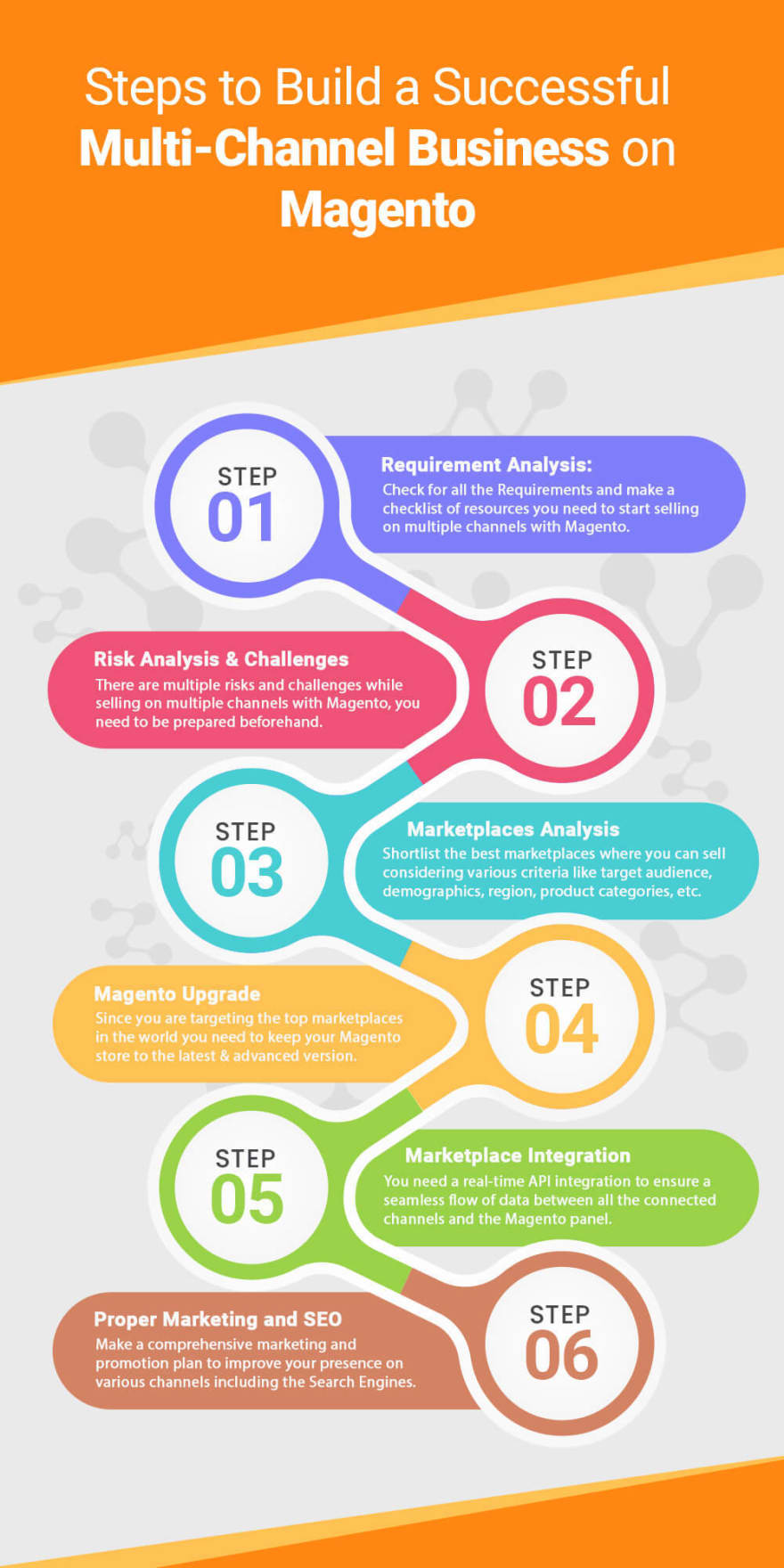This is a complete guide on how to build a powerful multi-channel eCommerce business on Magento.
Selling on one channel is outdated. Relying on a single channel is similar to drinking water from a spoon. Customers have become accustomed to exploring various platforms for shopping. So as a Magento seller, it becomes your responsibility to strengthen your eCommerce selling game through multi-channel eCommerce. Here’s how you can start multi-channel selling:
How to build a successful multi-channel eCommerce business on Magento?
A successful multi-channel eCommerce business requires a strong foundation on which the business is sustained. Here are 6 steps to start selling on multi-channels with your Magento store:

Requirement Analysis: Check for all the Requirements and make a checklist of resources you need to start selling on multiple channels with Magento.
Risk Analysis & Challenges: Multiple risks and challenges arise while selling on multiple channels with Magento. To stay unaffected from it, you need to analyze them beforehand.
Marketplaces Analysis: Shortlist the best marketplaces where you can benefit from selling. This can be done on various criteria like target audience, demographics, region, product categories, etc.
Magento Upgrade: Since you are targeting the best marketplaces, you need to keep your Magento store to the latest version. For multi-channel eCommerce, it is advisable to prefer the Magento Commerce version rather than the basic community version.
Marketplace Integration: You need a real-time API integration to ensure a seamless flow of data between all the connected channels and the Magento panel. Since there are so many things at stake, you can’t take any chances with laggy and outdated integrations.
Proper Marketing and SEO presence: Your presence on multiple channels can only be useful if your potential customers know about it. Make a comprehensive marketing and promotion plan to improve your presence on various channels, including the Search Engines.
Now, let us go through the steps to start multi-channel selling with Magento; one at a time:
Step 1: Requirement Analysis:
Before commencing with multi-channel eCommerce you need to ensure that your Magneto store is compatible with this. Make a checklist of the necessary things to do before you start multi-channel selling.
Some of these things include:
- Magento Store Speed Optimisation
- Resolve urgent issues and critical bugs.
- Addition of any new 3rd party extensions Update Inventory to keep your site current.
All done? Great
Once you are finished with these, you have taken the very first step towards building a successful multi-channel business on Magneto.
Next comes Risk analysis.
Step 2: Risk and Challenges Analysis:
Selling on multiple channels comes with a lot of uncalled complications and risks. And as a responsible seller, you need to be aware of these risks of multi-channel eCommerce.
Some of the risks that most Magento multi-channel eCommerce business sellers face are:
- Sudden demand and supply crisis.
- Maintaining a smooth cash flow.
- Refunds and Return rate.
- Keeping up with the seller rating.
- and many more If you are aware of all these risks and challenges, you can easily plan for an alternative solution when such a scenario arises.
You need to be prepared beforehand and come out on top of all others.
Step 3: The Marketplace Analysis:
Now, this is the most crucial step in building a powerful multi-channel business on Magento – the marketplace analysis.
While choosing the channels or marketplaces, you need to be very careful. You need to consider all the pros and cons of these shortlisted marketplaces and proceed with the ones that fit your business.
The points to consider before choosing a marketplace to sell:
-The Marketplace traffic
- Customer base
- Key strengths of the marketplace
- The Fee structure and commission rate
- Terms and conditions for selling
- Fulfillment services
- Returns and refund policies
- Customer support from marketplaces Once you have gone through all the above criteria, you can easily select the best eCommerce marketplaces for your Magento based business.
Since you have chosen the channels to sell, now, you need to make sure that your website is upgraded with the latest version of Magento.
Refer this blog to know more about building multichannel business



Top comments (0)